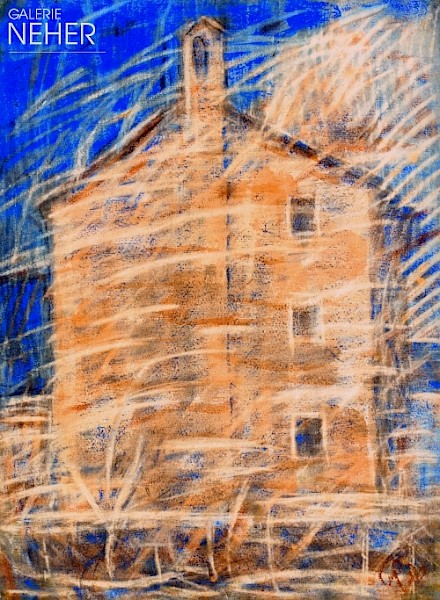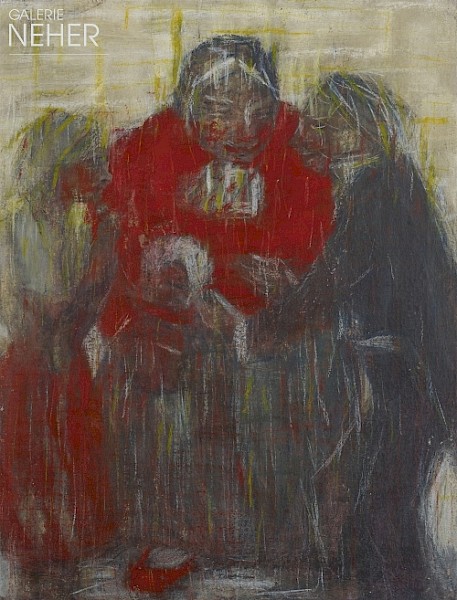Christian Rohlfs
* 22 12 1849 | Niendorf
† 08 01 1938 | Hagen
He was one of the very special German modern artists in the first half of the 20th century. The multifarious work of Christian Rohlfs passed through extremely different periods, from Realism through Impressionism and Expressionism to a unique, highly individual late work of intensified expression and astonishing painterly richness.
Works by Christian Rohlfs
Vita Christian Rohlfs
1849
Born on 22 December in Niendorf, Holstein.
1864
Rohlfs falls out of a tree, injuring his leg and must keep to his bed for two years. The Segeberg doctor gives the boy drawing materials. He recognises and encourages the gift of his charge.
1866
Attends secondary school in Bad Segeberg.
1870
Commences with studies at the Grand-Ducal Saxon Art School in Weimar.
1871
His leg ailment grows worse. A hospital stay in Jena is necessary.
1874
Amputation of the right leg due to chronic bone marrow infection.
1875
Study stays in Weißenfels and Dresden. First sketchbooks.
1879
Study trip to Eisenach and the Rhön Mountains
1881
Rohlfs shares a free studio with the painter Eddelbüttel.
1884
End of studies. Rohlfs attempts to work as a freelance artist in Weimar.
1888
First signs of an Impressionist painting style in his work.
1895
One-year stay in Berlin at the invitation of the composer Bischof, which he repeats in the following year.
1899
Stay in Lübeck and at the Bay of Lübeck.
1901
Contact with the museum founder Karl Ernst Osthaus. He moves into studio rooms in his Hagen museum in the following year.
His work begins to demonstrate Expressionist tendencies.
1902
Stay in Weimar. He is awarded a professor title by the Weimar Academy.
1903
Stay of several weeks in Weimar. First watercolours.
He becomes familiar with works of Van Gogh and the French avant garde at the Museum Folkwang in Hagen, which influence his work.
1905
Rohlfs spends the summer in Soest and becomes friends with Emil Nolde.
1906
Spends the summer in Soest again, the winter in Hagen.
1907
Rohlfs becomes a member of the Separate League of West German Art Lovers and Artists.
1908
Stays in Weimar, in the Rhön Mountains and in Upper Bavaria, as well as in Berlin.
First woodcut prints.
1909
He becomes a member of the German Werkbund. His works are shown in an exhibition in the Folkwang Museum in Hagen.
1910
Rohlfs goes to Munich for two years, where he takes a studio.
1912/13
Travel to Tirol and the Sauerland.
1914
Rohlfs is unable to work for several months due to the outbreak of the war. Works with religious themes originate, influenced by the war.
He becomes a member of the Free Secession in Berlin.
1919
He marries the 41-year younger Helene Vogt, whom he had met the year before. Several exhibitions on the occasion of his 70th birthday, including in the National Gallery in Berlin.
1920
The following years are characterised by much travel, including to Mittenwald, Munich, Dinkelsbühl and Rothenburg.
A turn toward large-format works with water-based tempera on paper.
1922
The artist is awarded an honorary doctorate by the Technical University of Aachen. Holstein sketchbook.
1924
Declared an honorary citizen of the city of Hagen on the occasion of his 75th birthday. Rohlfs becomes a member of the Prussian Academy of Arts in Berlin.
1925
He is awarded the title of honorary doctor by the University of Kiel, while the Düsseldorf Art Academy names him an Extraordinary Member.
1927
First trip to Ascona on Lago Maggiore, moves into Casa Lisibach.
1929
Rohlfs and his wife spend the summer months in Ascona from now on.
The Christian Rohlfs Museum is founded in Hagen on the occasion of his 80th birthday. Several exhibitions take place, including in the Museum Folkwang in Essen.
1931
The Tatjana Cycle is created, inspired by the modern dancer Tatjana Barbakoff.
1933
The Louvre in Paris purchases one of his works.
1936
The Detroit Institute of Arts exhibits his works.
1937
Rohlfs is classified as a “degenerate artist“ and is expelled from the Prussian Academy of Arts. His works are removed from museums.
1938
The artist dies in his Hagen studio on 8 January.
Commemorative exhibitions take place in Basel and Bern.
Several of his works are shown posthumously at documenta 1 in 1955.


